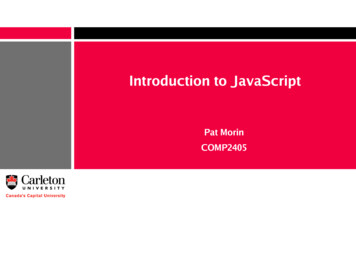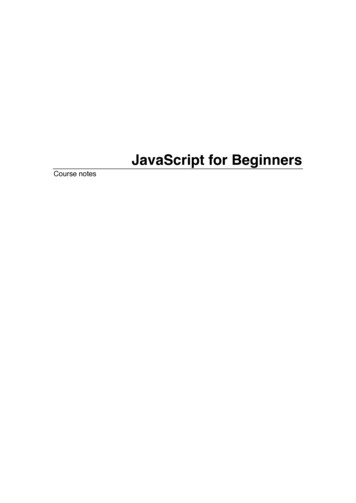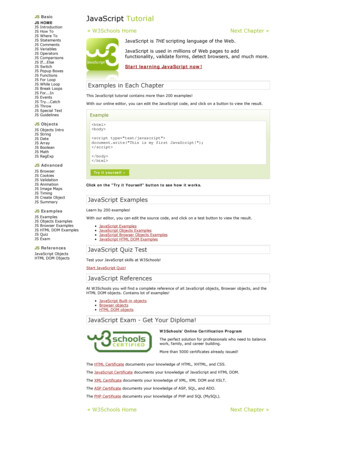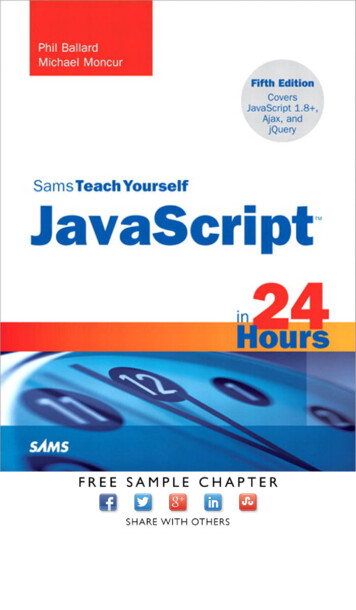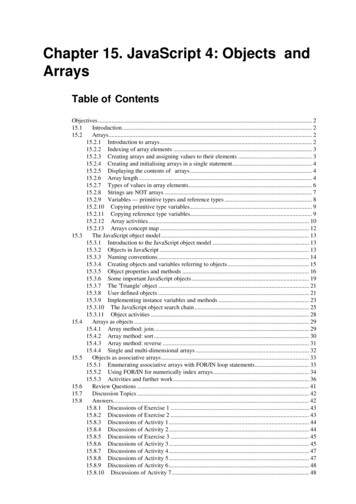
Transcription
Chapter 15. JavaScript 4: Objects andArraysTable of ContentsObjectives . 215.1Introduction . 215.2Arrays . 215.2.1 Introduction to arrays . 215.2.2 Indexing of array elements . 315.2.3 Creating arrays and assigning values to their elements . 315.2.4 Creating and initialising arrays in a single statement. 415.2.5 Displaying the contents of arrays . 415.2.6 Array length . 415.2.7 Types of values in array elements . 615.2.8 Strings are NOT arrays . 715.2.9 Variables — primitive types and reference types . 815.2.10 Copying primitive type variables . 915.2.11 Copying reference type variables. 915.2.12 Array activities. 1015.2.13 Arrays concept map . 1215.3The JavaScript object model . 1315.3.1 Introduction to the JavaScript object model . 1315.3.2 Objects in JavaScript . 1315.3.3 Naming conventions . 1415.3.4 Creating objects and variables referring to objects . 1515.3.5 Object properties and methods . 1615.3.6 Some important JavaScript objects . 1915.3.7 The 'Triangle' object . 2115.3.8 User defined objects . 2115.3.9 Implementing instance variables and methods . 2315.3.10 The JavaScript object search chain . 2515.3.11 Object activities . 2815.4Arrays as objects . 2915.4.1 Array method: join . 2915.4.2 Array method: sort . 3015.4.3 Array method: reverse . 3115.4.4 Single and multi-dimensional arrays . 3215.5Objects as associative arrays . 3315.5.1 Enumerating associative arrays with FOR/IN loop statements . 3315.5.2 Using FOR/IN for numerically index arrays. 3415.5.3 Activities and further work . 3615.6Review Questions . 4115.7Discussion Topics . 4215.8Answers. 4215.8.1 Discussions of Exercise 1 . 4315.8.2 Discussions of Exercise 2 . 4315.8.3 Discussions of Activity 1 . 4415.8.4 Discussions of Activity 2 . 4415.8.5 Discussions of Exercise 3 . 4515.8.6 Discussions of Activity 3 . 4515.8.7 Discussions of Activity 4 . 4715.8.8 Discussions of Activity 5 . 4715.8.9 Discussions of Activity 6 . 4815.8.10 Discussions of Activity 7 . 48
15.8.1115.8.1215.8.13Discussions of Activity 8 . 49Answers to Review Questions . 51Contribution to Discussion Topics. 51ObjectivesAt the end of this chapter you will be able to: Understand the basic features of JavaScript arrays;Understand the fundamental elements of JavaScript arrays;Write HTML files using JavaScript arrays;Explain the JavaScript object model;Use arrays as objects.15.1IntroductionMost high level computer programming languages provide ways for groups of related data to be collectedtogether and referred to by a single name. JavaScript offers objects and arrays for doing so. JavaScript arrays arerather different from arrays in many programming languages: all arrays are objects (as in many other languages),but they are also associative arrays. Also, all objects can also be used as if they, too, are arrays.This chapteris organised into four sections. It introduces arrays and objects separately, then considers arrays asobjects, then finally considers objects as (associative) arrays. Many important concepts are covered in this unit,although much of the object technology concepts have been introduced in earlier units.When working with variables, an important distinction has to be made: is the variable contain the value of aprimitive type, or does it contain a reference to a (non-primitive) collection of data. A thorough grounding in theconcepts covered in this chapter is necessary to both be able to understand the sophisticated Javascipt scripts writtento support complex websites, and to be able to begin developing JavaScript solutions yourself for real worldproblems. It is important to work through examples until you understand them; write your own programmes thatuse and test your learning. Programming is learnt through doing as much, or more so, than by reading.15.2Arrays15.2.1 Introduction to arraysArrays provide a tabular way to organise a collection of related data. For example, if we wished to store the sevennames of each weekday as Strings, we could use an array containing seven elements. This array would be structuredas follows:IndexValueweekDays[0] "Monday"weekDays[1] "Tuesday"weekDays[2] "Wednesday"weekDays[3] "Thursday"weekDays[4] "Friday"weekDays[5] "Saturday"weekDays[6] "Sunday"As can be seen all of these different String values are stored under the collective name weekDays, and a number(from 0 to 6) is used to state which of these weekDays values we specifically wish to refer to. So by referring toweekDays[3] we could retrieve the String "Thursday".DEFINITION - Array2
An array is a tabular arrangement of values. Values can be retrieved by referring to the array name together withthe numeric index of the part of the table storing the desired value.As you may have spotted, by having a loop with a numeric variable we can easily perform an action on all, or somesub-sequence, of the values stored in the array.15.2.2 Indexing of array elementsAs can be seen from the above figure, there are seven elements in the weekDays array.DEFINITION — elementArrays are composed of a numbered sequence of elements. Each element of an array can be thought of as a row (orsometimes column) in a table of values.The seven elements are indexed (numbered) from zero (0) to six (6). Although it might seem strange to start bynumbering the first element at zero, this way of indexing array elements is common to many high-levelprogramming languages (include C, C and Java), and has some computational advantages over arrays that startat 1.NoteThe index of an array element is also known as its subscript. The terms array index and array subscript can be usedinterchangeably. In this unit we consistently use the term index for simplicity.Exercise 1Answer the following questions about the weekDays array: What is the first element? What is the last element? What is the 4th element? What is the value of the first element? What is the value of the 4th element? What is the element containing String "Monday"? What is the element containing String "Saturday"? What is the index of the element containing String "Monday"? What is the index of the element containing String "Saturday"?15.2.3 Creating arrays and assigning values to theirelementsThere are a number of different ways to create an array. One piece of JavaScript code that creates such an array isas follows:// VERSION 1var weekDays new Array(7); weekDays[0] "Monday"; weekDays[1] "Tuesday"; weekDays[2] "Wednesday"; weekDays[3] "Thursday";weekDays[4] "Friday"; weekDays[5] "Saturday"; weekDays[6] "Sunday";The first (non-comment) line is:var weekDays new Array(7);3
This line declares a new variable called weekDays and makes this new variable refer to a new Array object that canhold seven elements.NoteThe concept of arrays as objects is discussed later this unit.The seven statements that follow this line assign the Strings "Monday" - "Sunday" to the array elementsweekDays[0] to weekDays[6] respectively.15.2.4 Creating and initialising arrays in a singlestatementAnother piece of JavaScript that would result in the same array as VERSION 1 above is the following:// VERSION 2 - all in one linevar weekDays new Array( "Monday", "Tuesday", "Wednesday","Thursday", "Friday", "Saturday", "Sunday");This single statement combines the declaration of a new variable and Array object with assigning the seven weekdayStrings. Notice that we have not had to specify the size of the array, since JavaScript knows there are seven Stringsand so makes the array have a size of seven elements.The above examples illustrate that arrays can either be created separately (as in VERSION 1), and then havevalues assigned to elements, or that arrays can be created and provided with initial values all in one statement(VERSION 2).When declaring the array, if you know which values the array should hold you would likely choose to create thearray and provide the initial values in one statement. Otherwise the two-stage approach of first creating the array,and then later assigning the values, is appropriate.15.2.5 Displaying the contents of arraysThe easiest way to display the contents of an array is to simply use the document.write() function. This function,when given an array name as an argument, will display each element of the array on the same line, separated bycommas. For example, the code:var weekDays new Array( "Monday", "Tuesday", "Wednesday", "Thursday","Friday", "Saturday", "Sunday");document.write( " b Weekdays: /b " weekDays);Produces the following output in a browser:15.2.6 Array lengthThe term length, rather than size, is used to refer to the number of elements in array. The reason for this will becomeclear shortly.As illustrated in the VERSION 1 code above, the size of an array can be specified when an array is declared:var weekDays new Array(7);4
This creates an array with seven elements (each containing an undefined value):IndexValueweekDays[0] undefined weekDays[1] undefined weekDays[2] undefined weekDays[3] undefined weekDays[4] undefined weekDays[5] undefined weekDays[6] undefined In fact, while this is good programming practice, it is not a requirement of the JavaScript language. The line writtenwithout the array size is just as acceptable to JavaScript:var weekDays new Array();this creates an array, with no elements:Index ValueIn this second case, JavaScript will make appropriate changes to its memory organisation later, once it identifieshow many elements the array needs to hold. Even then, JavaScript is a can extend the size of an array to contain moreelements than it was originally defined to contain.For example, if we next have the statement:weekDays[4] "Friday";the JavaScript interpreter will identify the need for the weekDays array to have at least five elements, and for whichthe 5th element is the String "Friday".IndexValueweekDays[0] undefined weekDays[1] weekDays[2] undefined undefined weekDays[3] undefined weekDays[4]"Friday"If this were then followed by the statement:weekDays[6] "Sunday";the JavaScript interpreter will identify the need for the weekDays array to now have seven elements, of which the5th contains the String "Friday" and the 7th contains "Sunday":IndexValueweekDays[0] undefined weekDays[1] undefined weekDays[2] undefined weekDays[3] undefined weekDays[4] "Friday"5
IndexValueweekDays[5] undefined weekDays[6] "Sunday"Once created, an array has a length property. This stores the number of elements for which JavaScript has madespace. Consider the following statements:var weekDays new Array(7); var months new Array();var bits new Array(17, 8, 99);The length of each of these arrays is as follows: weekDays.length 7 months.length 0 bits.length 3One needs to be careful, though, since making the length of an array smaller can result in losing some elementsirretrievably. Consider this code and the following output:var bits new Array(17, 8, 99, 33, 66, 11);document.write(bits);document.write(" br array length: " bits.length);bits.length 4;document.write(" p after change: /p ");document.write(bits);document.write(" br array length: " bits.length);The browser output from such code is:As can be seen, after the statement bits.length 4; the last two array elements have been lost.15.2.7 Types of values in array elementsIn most high-level programming languages arrays are typed. This means that when an array is created theprogrammer must specify the type of the value to be stored in the array. With such languages, all elements of anarray store values of a single type. However, JavaScript is not a strongly typed programming language, and afeature of JavaScript arrays is that a single array can store values of different types.Consider the following code:var things new Array(); things[0] 21;things[1] "hello";things[2] true;document.write(" p [0]: " things[0]);document.write(" p [1]: " things[1]);document.write(" p [2]: " things[2]);6
As can be seen, this is perfectly acceptable JavaScript programming:When the value of an array element is replaced with a different value, there is no requirement for the replacementvalue to be of the same type. In the example below, array element 1 begins with the String "hello", is then changed tothe Boolean value false, and changed again to the number 3.1415:var things new Array(); things[0] 21;things[1] "hello"; things[2] true; things[1] false; things[1] 3.1415;document.write(" p [0]: " things[0]);document.write(" p [1]: " things[1]);document.write(" p [2]: " things[2]);As can be seen, this changing of array element values of different types works without problems:We can confirm that a single array can store values of different types by displaying the return value of the typeoffunction:var things new Array(); things[0] 21;things[1] "hello";things[2] true;document.write(" p type of things[0]:" typeof things[0] );document.write(" p type of things[1]: " typeof things[1] );document.write(" p type of things[2]: " typeof things[2] );The output of the above code is as follows:15.2.8 Strings are NOT arraysIn many programming languages, text strings are represented as arrays of characters. While this makes sense in nonobject oriented languages, there are a number of advantages of representing data such as text as objects (see laterthis unit).You will only obtain undefined values if you attempt to refer to particular characters of Strings using the squarebracket array indexing syntax.7
For example, the codevar firstName "Matthew";document.write("second letter of name is: " firstName[1]);It is also easy to confuse String and Array objects because they both have a length property. So the code:var firstName "Matthew";document.write("second letter of name is: " firstName[1]);document.write(" p length of 'firstName' " firstName.length);is valid, and we do see the number of characters of the String displayed:However, the similarity is because both Strings and Arrays are objects — see later in this unit for a detaileddiscussion of JavaScript objects.15.2.9 Variables — primitive types and reference typesWhen one begins to work with collections of values (e.g. with arrays or objects), one needs to be aware of thevariable's value. A variable containing a primitive type value is straightforward: for example consider the numericvariable age in this code:var age 21;However, the situation is not so simple when we consider an array variable. For example the ageList array of threeages defined as follows:var ageList new Array( 3 ); ageList[0] 5;ageList[1] 3;ageList[2] 11;It is not the case that ageList is the name for a single location in memory, since we know that this array is storingthree different values. The location in memory named ageList is actually a reference to the place in memory wherethe first value in the array can be found. The diagram below attempts to illustrate this:NoteThere is nothing special about the locations 001727 etc., these numbers have been made up and included toillustrate unnamed locations in memory.So we can think of the variable ageList as referring to where the array values can be found.The implication of the different between variables of primitive types and reference types is rather important,8
especially in the case of copying or overwriting the values of reference variables.15.2.10 Copying primitive type variablesWith primitive type variables it is straightforward to copy and change values. Consider the following code:var name1 "ibrahim"; var name2 "james";Initially the memory looks as follows:Memory Location Valuename1"Ibrahim"name2"James"Then if we execute the following lines:name1 name2; name2 "fred";the values in memory will be:Memory Location Valuename1"James"name2"fred"What is happening is that when one variable is assigned the value of a second, a copy of the second variable's valueis placed into the location in memory for the first — so a copy of the value "james" from name2 was copied into thelocation for name1.15.2.11 Copying reference type variablesThings are different when one is working with variables of reference types. Consider the following code, wherefirst an array called myArray is created with some initial values, next a variable called thing2 is assigned the valueof myArray:var myArray new Array( 6, 3, 5, 1 ); var thing2 myArray;Since myArray is a reference to the array values in memory, what has been copied into thing2 is the reference — sonow both myArray and thing2 are referring to the same set of values in memory:The implications are that if a change is made to the array values, since both myArray and thing2 are referring to thesame values in memory, both will be referring to the changed array.Exercise 29
What is the value of myArray[2] after the following statements have been executed?var myArray new Array( 6, 3, 5, 1 ); var thing2 myArray;thing2[1] 27;thing2[2] 19;thing2[3] 77;15.2.12 Array activitiesActivity 1: Creating and displaying elements of an arrayWrite an HTML file that creates an array called ages containing the following numbers: 21, 14, 33, 66, 11. Writecode so that the values of array elements 0, 1 and 3 are displayed. The screen should look similar to the followingwhen the page is loaded:You can find a discussion of this activity at the end of the unit.Activity 2: Iterating through array contentsCreate an array called primes containing the following numbers: 1, 2, 3, 5, 7, 11.Write a while loop that will iterate (loop) through each element of the array, displaying each number on a separateline. Your code should be written in a general way, so if more numbers were added to the array (say 13, 17 and 19)the loop code would not need to be changed.The browser output should be something like:You can find a discussion of this activity at the end of the unit.Activity 3: Animation using an array of Image objectsCreate a Web page that shows an image, and when the mouse goes over this image the image is replaced with an10
animation of 3 other images before returning back to the original image. Make the original image: silence.gif, withbrowser output as follows:Make the three images that are animated: taptap.gif, knockknock.gif and BANGBANG.gif, with browser outputs asfollows:11
Create an array of Image objects called images. You only need to refer to the src property as in the following lines:// set up image array images[0] new Image();images[0].src "taptap.gif";In the body section of the HTML file display the silence image (naming it noise) with an appropriateonMouseOver JavaScript one-liner: BODY IMGNAME "noise"onMouseOver "startAnimation()" /BODY SRC "silence.gif"Create a function startAnimation() that sets the delay time and the imageNumber to display first in the animation.Your startAnimation() function should then make a call to an animate() function written as follows:function animate(){document.noise.src images[imageNumber].src;imageNumber ;delay 250;if( imageNumber 4 )setTimeout( "animate()", delay );// if imageNumber 4 the animation has finished// and this function can terminate}You might create a simple version with an unchanging delay of 500 milliseconds initially. Notice how the line:document.noise.src images[ imageNumber ].src;refers to the NAME of the image from the IMG tag, and resets the src property of this Image object to the appropriatearray Image object src.You can find a discussion of this activity at the end of the unit.15.2.13 Arrays concept mapThis figure illustrates the way different array concepts can be related.12
15.3The JavaScript object model15.3.1 Introduction to the JavaScript object modelIt is practically impossible to write useful JavaScript without using object properties and methods — even thoughmany novice programmers do not realise they are making use of JavaScript objects.Consider the following line of code:document.write( "Sorry, that item is out of stock" );The above line illustrates the use of many important object concepts, since it involves creating a new object("Sorry." is an instance built from the String constructor function), passing a reference to this new object as anargument to a method of another object (write() is a method of the document object).JavaScript has a powerful and flexible object model. Unlike the Java programming language, JavaScript is a classless language: the behaviour and state of an object is not defined by a class, but rather by other objects (in the caseof JavaScript, this object is called the object's prototype. While this major difference to languages such as Javaand C often leads people to conclude that the JavaScript object model is a simple one, the JavaScript objectmodel is powerful enough to allow a JavaScript programmer to extend its single inheritance abilities to allow forimplementations of multiple inheritance, but also most of the functionality that JavaScript is considered to have"missing". All of this may also be done dynamically, at runtime — in other words, prototypes are defined while theJavaScript programme is executing, and can be updated with new methods and properties as and when they arerequired, and not only at compile time as with languages such as Java.As you progress through this part of the unit, you will both learn new ways to use and define your own objectsand constructor, and also you will come to more fully understand many JavaScript programming concepts youhave learned up to now. The remainder of this introduction provides a more detailed overview of the JavaScriptobject model presented briefly in the first JavaScript unit.15.3.2 Objects in JavaScriptA software system is considered to be a set of components — objects — that work together to make up the system.Objects have behaviour (defined by functions and methods) that carries out the system's work, and state, whichaffects its behaviour. As we previously mentioned, objects may be created and used by programming a constructorfunction to create objects, or instances. A constructor is merely a JavaScript function that has been designed to beused with the new keyword. The constructor defines what properties an object should have (the object's state), as wellas its methods.13
Programming an object involves declaring instance variables to represent the object's state, and writinginstance methods that implement behaviour. The separate parts of an object's state are often called its properties.Thus, you might have a bank account object which had properties such as holder of account, address of holder,balance and credit limit; its methods would include the likes of credit, debit and change address.JavaScript represents functions (which are used to implement methods, and to create objects) as data of typeFunction (notice the capital F), so in fact there is less difference between data properties and functions (ormethods) than in most other object-based programming languages. Functions can be passed and stored in variables,and any function stored in a particular variable can be executed when required.An object is said to encapsulate its state (often simply called its data) and its behaviour. In the case of JavaScript,this means that each object has a collection of properties and methods.A JavaScript object can inherit state and behaviour from any other object. This object is called aprototype.An object can obtain properties and methods from the constructor function from which the object is created; from itsprototype, through inheritance; and from any properties and methods added separately to the object after it has beenconstructed (remember that Functions are just data that can be freely assigned to variables, as and when required).Two objects made from the same constructor function can have different properties and methods from each other,since extra properties and methods can be added to each object after they have been created.Associated with inheritance is the separate concept of polymorphism, the ability to call a method on an objectirrespective of the constructor function used to create the object, and expect the appropriate method to be called forthe given object. For example, there can be two constructor functions, Square() and Circle(), which create objectsrepresenting squares and circles, respectively. The constructor can create these objects so that they each have anarea() method that returns the area of the object. Of course, the method will operate differently for square and circleobjects, but any variable holding either a square or a circle object can have the area method called on it, andpolymorphism will ensure that the correct area method is called for the appropriate object.15.3.3 Naming conventionsAlthough it can initially seem rather pedantic, the following naming convention is used throughout this unit, and iswidely used in various programming standards. Using a standard convention helps a programmer to understand thecode that they are reading, and you are advised to adopt this convention in your own programming.All words of a constructor are spelt with an initial capital letter. Examples include: Document Form Triangle Array String BankAccount CreditCardThe first word in an instance (object) name is
Write HTML files using JavaScript arrays; Explain the JavaScript object model; Use arrays as objects. 15.1 Introduction Most high level computer programming languages provide ways for groups of related data to be collected together and referred to by a single name. JavaScript offers objects and arrays for doing so.
